Car Paint Restoration:
Restoring 2-stage, clear coat car paint
Car paint restoration with today's modern day car paint finishes is much different than the days of old.
Unlike old school single stage paint jobs which could include anything from enamels, acrylics, or the ultimate in wet-look shine of a 20 layer, color-sanded lacquer paint job, modern day 2-stage paints are far easier than ever to care for and maintain.
No longer do we get the chalky oxidation of paint that turned reds into chalky pinks, and blacks into chalky greys, or white into....well, just chalky looking white.
The oxidation process of clear coat is vastly different than that of the older, single stage paint jobs that lacked the protection offered by modern day clear coats.
Understanding the Nature of the Beast
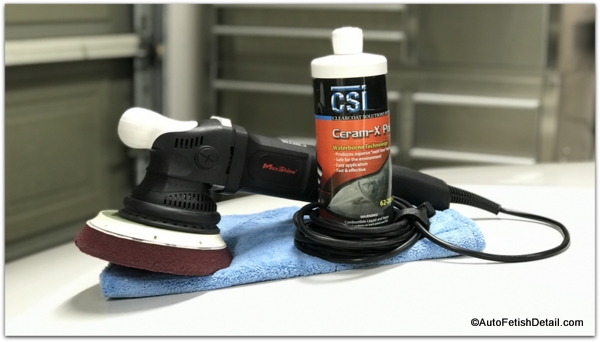
This page is not intended as a lengthy discussion on clear coats, but on car paint restoration. With that said, it is important to lay out a few facts regarding clear coats for all the true beginners out there:
- Any car made today will have what is called a 2-stage paint job. Different than a single stage paint job in that the top layer is finished with a clear protective layer known as clear coat.
- While the industry preys upon your ignorance as a consumer and car owner, just as so-called experts like to over-dramatize the subject of clear coats by suggesting that special care and special products are required, this is essentially nothing more than misrepresentation and hype.
- Clear coats are essentially car paint with no pigments,and therefore need the same care and maintenance as old-school single stage paint jobs.
- Clear coat has been added to all paint jobs as part of the Original painting process done at the factory.
- Clear coat was developed as a permanent form of protection for the base color coat.
"Darren, what does this all have to do with car paint restoration?"
I am glad you asked. While clear coats are essentially clear car paint, there are some differences that should be noted and will help in restoring your car paint. Officially, most clear coats are acrylic urethane. If you wanted to really over-simplify the moment, you could even call the clear coat a form of plastic. Like many things in life, many terms exist and are used that are extreme generalizations and the term "plastic" is one of them.
Clear Coat Failure (car paint restoration is no longer an option)
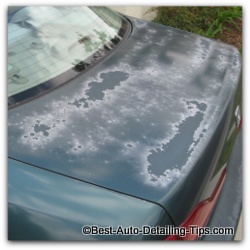
This picture depicts what is usually referred to in the business as clear coat failure. This is one of the big differences between single-stage paint and 2-stage paint. Clear coats don't actually oxidize in a way that single stage paint jobs do when they become dull, chalky, and faded.
Clear coat will start to "dry out" for lack of a better word. It eventually looks like it was washed with a rag full of sand and eventually will either completely burn out with absolutely no shine to it, or start to fail by lifting, blistering, and peeling like the picture shown.
If your paint looks like the one in the picture; you are past the point of trying to restore your car paint. (that ship has sailed and has left the harbor)
Dried Out Clear Coat (car paint restoration is definitely an option)
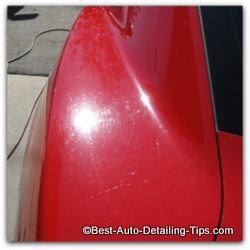
The picture taken from this red Camaro fender could actually highlight (2) problems when it comes to car paint restoration.
- Spider-webbing effect, and/or wash scratch.
- Neglected clear coat that has become dried out.
Beginners Guide to Restoring Your Car Paint
Most people reading this will be looking to restore the paint on their car for the same reasons that most car owners go in search of the best techniques to restore shine, luster, and beauty to their cars paint:
- Your car paint is beginning to age and looks less than you know it can or that is used to.
- Fine scratches, swirl marks, spider-webbing, wash-scratch, etc.
"Most people do not realize how much easier it is to restore the car paint with the latest in professional detail equipment and products"
The detailing industry is continually looking for ways to bridge the gap between professional detailing and inexperienced car owners or car enthusiasts who are looking to produce the same results as seasoned professional detail veterans.
The really good news is that with the right choice in tools and products, any newcomer to the world of car care can produce amazing results ans restore the paint on our car to a level never possible for the truly new beginner.
Complete Car Paint Restoration Kits
Yes, believe it or not, anyone can now put themselves behind this paint restoration system and produce amazing results that were traditionally reserved for professional detailers.
With the combination of the user friendly DA (dual-action/random orbital) car buffer, the right car polishes and polishing pads, now a true beginner can achieve amazing results right out of the box!
Car Paint Restoration:
Adam's Car Paint restoration Kit
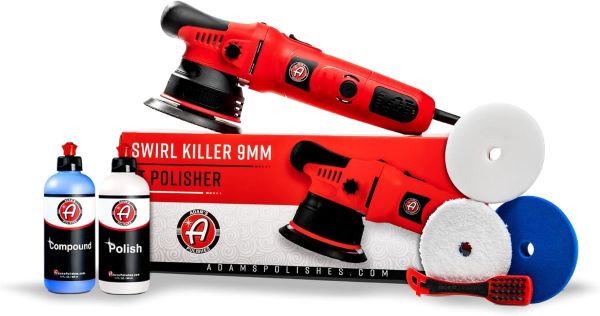
Adam's Car Polishing kit on Amazon
About this item
-
Powerful Dual Action Buffer for Efficient Paint Correction:
The Adams Polishes 9mm Dual Action Long Throw Polisher delivers 1000 watts of power for strong torque and consistent performance on any surface. Achieve swirl-free, and scratch-free results with ease. -
Ergonomic and Balanced Design:
Concave rubber grip points absorb vibration and improve control. A built-in balance block enhances comfort and makes storage simple. The soft-touch head cover ensures a comfortable and confident detailing experience. -
Removes Swirls, Scratches, and Defects:
The Adams Swirl Killer 9mm DA Polisher is a versatile tool for more than just paint correction. Use it to scrub carpets, polish chrome or aluminum, or apply glazes, sealants, and wax. Weighing under 5.5 pounds and featuring a 16-foot cord, it is light, agile, and efficient. -
Strong Correcting Ability:
With 1000 watts of power and up to 6500 orbits per minute, this tool maximizes surface coverage with a 9mm orbit. It distributes polishes and compounds evenly across any vehicle size, delivering reliable performance for years of paint correction. -
Satisfaction Guarantee:
Adams Polishes stands behind its full range of professional detailing products—from waxes and sealants to microfiber towels and tools. If you are not completely satisfied, contact us and we will make it right.
Darren's Professional Tips:
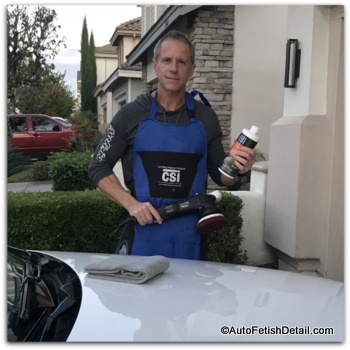
The problem I see with a lot of beginners is they are overwhelmed with all the choices and all the voices! Everyone has a different opinion...
myself included!
So let me break it down for you as to why I don't think you need to go into anxiety mode when trying to perform car paint restoration, or over-think the buying decision.
- Today's world is filled with many quality car polishers/buffers. (it would seriously be hard to go wrong)
- Random orbital car polishers are as safe as safe can get! (which is why any beginner can confidently get amazing results straight out of the box)
- Not only are the car buffers incredibly safe and user friendly, but the polishes and pads are incredibly good and will produce professional results. (any beginner today will not fully appreciate just how good they have it compared to when I first started out)
- You can remain in "analysis paralysis" forever. Doing so will also mean you never get what you are really after: amazingly shiny paint!!
I hope I have helped with useful information to get you off the fence and to start polishing your car and perform some car paint restoration on your own baby!
I wish you much success!
Sincerely,
Darren Priest
- Home
- Auto Paint Detailing
- This Page
|
|

